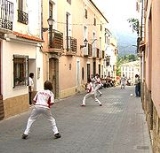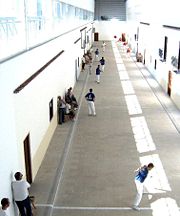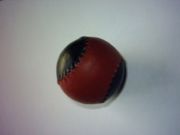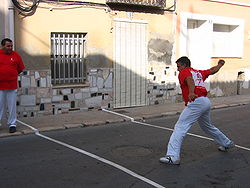
Llargues
Encyclopedia
Llargues (ˈʎaɾɣes, "long ones") is the oldest Valencian pilota
modality. It's played on the streets, where two teams formed by 3, 4 or 5 players throw each other the ball with the hand try to surpass an imaginary line which changes every game.
There are no professional players, but it's very common in the towns and villages of some regions of the Valencian Community
, such as the Marina Alta
and Baixa
, l'Alacantí
, l'Alcoià
and the Comtat
.

 The chosen place must be a plain, straight, wide and long street, measuring 70 m at most. If one of the sides is upset the downside will be assigned to the "rest", the same if one of the sides is wider.
The chosen place must be a plain, straight, wide and long street, measuring 70 m at most. If one of the sides is upset the downside will be assigned to the "rest", the same if one of the sides is wider.
Street is limited by two lines: the banca line and the rest line which mark the end of both sides. There is also another line, the fault line which signals the point the ball must surpass when serving, at 40 m from the rest. In case one of the playing teams is clearly stronger they may give some steps, that is, to allow the banca line to be a bit more advanced in order to compensate for the stronger opponent serve.
Spectators may seat on each sides of the sidewalk and behind the street end lines.
 Llargues are played with a badana ball, which can be played without any protection. Since this sport is practiced on the streets and the bounce is very irregular this kind of ball almost doesn't bounce. They are cheap, so it doesn't matter if any ball is lost on the roofs, at another street or in any balcony (which happens often). Also, streets have plenty of irregularities such as borders or traffic signals, and many places with a different rebound (walls and doors, ground or gutter lids), that cause strange effects to the trajectory of the ball, those unexpected directions are somehow minimized by the soft rebound of the badana ball since it's made of moulding materials. Another eason to use this ball is its slowness and softness, so that it's proper for amateur or casual players.
Llargues are played with a badana ball, which can be played without any protection. Since this sport is practiced on the streets and the bounce is very irregular this kind of ball almost doesn't bounce. They are cheap, so it doesn't matter if any ball is lost on the roofs, at another street or in any balcony (which happens often). Also, streets have plenty of irregularities such as borders or traffic signals, and many places with a different rebound (walls and doors, ground or gutter lids), that cause strange effects to the trajectory of the ball, those unexpected directions are somehow minimized by the soft rebound of the badana ball since it's made of moulding materials. Another eason to use this ball is its slowness and softness, so that it's proper for amateur or casual players.
It's made of rags with skin of sheep. Weight: 39 gr as much, diameter: 38 mm.
Teams wear in red and blue t-shirts, being red the colour of the team allegedly stronger or favourite in the bets.
Players receive a name depending on their position on the street:
Every point consists in four quinzes: 15, 30, val, and joc. The team who wins the joc scores a point.
 The quinze begins when the banca serves: From the other side of the banca line the player must send himself the ball and (without any bounce) hit it to throw it so that it surpasses the fault line without touching the ground, then the opposing team may hit it back or block it so that it doesn't advance anymore.
The quinze begins when the banca serves: From the other side of the banca line the player must send himself the ball and (without any bounce) hit it to throw it so that it surpasses the fault line without touching the ground, then the opposing team may hit it back or block it so that it doesn't advance anymore.
In Llargues the ball must be hit with the hand when it's on the air or after its first rebound on the ground, to send it to the opposing team's field or behind the line that marks the end of the street. When the player blocks the ball he may touch it with any part of his body (but only after the second bounce), in that case a line is done on the ground (actually, a signal is placed on the sidewalk).
The main feature of Llargues are the ratlles (Valencian
for lines), the signals set in the place where the ball has been blocked every quinze. The ball may be blocked because it's been thrown to the spectators and hasn't come back to the playing area, or, more likely, because a player has chosen to stop its advance when he realized he can't hit it back properly. In case the ball gets blocked on any roof or balcony the quinze is lost for whoever sent it there.
When a team has got 2 ratlles teams change the fields they'll try to score those pending points. Also, if the banca team gets a val they must change the field, even if they have only one ratlla.
When serving, they try to get direct quinzes or win the pending ratlles. Those ratlles are now the fault line. This way, the farer they've got the ratlla the more places has to defend the opponent and the more non protected areas there will be.
Direct quinzes are scored when:
Or because a fault of the opponent:
variant) to a square drawn on the ground.
Valencian pilota
Valencian pilota is a traditional handball sport played in the Valencian Community. Its origins are not known, but seems to be related to the French Jeu de paume....
modality. It's played on the streets, where two teams formed by 3, 4 or 5 players throw each other the ball with the hand try to surpass an imaginary line which changes every game.
There are no professional players, but it's very common in the towns and villages of some regions of the Valencian Community
Valencian Community
The Valencian Community is an autonomous community of Spain located in central and south-eastern Iberian Peninsula. Its capital and largest city is Valencia...
, such as the Marina Alta
Marina Alta
Marina Alta is a comarca in the province of Alicante, Valencian Community, Spain.- Municipalities :*Adsubia*Alcalalí*Beniarbeig*Benidoleig*Benigembla*Benimeli*Benissa*Benitachell/El Poble Nou de Benitatxell*Calp*Castell de Castells*Dénia...
and Baixa
Marina Baixa
Marina Baixa is a comarca in the Valencian Community, Spain. It is bordered by the comarques of Comtat on the northwest, Marina Alta on the northeast, Alacantí and Alcoià on the west and the Mediterranean Sea on the east....
, l'Alacantí
Alacantí
Alacantí is a comarca in the Valencian Community, Spain. It is bordered by the comarques of Marina Baixa and Alcoià to the north and Baix Vinalopó to the south....
, l'Alcoià
Alcoià
Alcoià is a comarca in the province of Alicante, Valencian Community, Spain.- Municipalities :*Alcoy/Alcoi*Banyeres de Mariola*Benifallim*Castalla*Ibi*Onil*Penàguila*Tibi...
and the Comtat
Comtat
Comtat is a comarca in the province of Alicante, Valencian Community, Spain.- Municipalities :*Agres*Alcosser de Planes*Alcoleja*Alfafara*Almudaina*L'Alqueria d'Asnar*Balones*Benasau*Beniarrés*Benilloba*Benillup*Benimarfull*Benimassot...
.

Playing area

Street is limited by two lines: the banca line and the rest line which mark the end of both sides. There is also another line, the fault line which signals the point the ball must surpass when serving, at 40 m from the rest. In case one of the playing teams is clearly stronger they may give some steps, that is, to allow the banca line to be a bit more advanced in order to compensate for the stronger opponent serve.
Spectators may seat on each sides of the sidewalk and behind the street end lines.
Ball

It's made of rags with skin of sheep. Weight: 39 gr as much, diameter: 38 mm.
Rules
Two teams formed by 4 or 5 players try to attain a certain score (usually 10 points) by throwing each oher a ball with the hand so that the opposing team is not able to send it back. Not so much ago there was another scoring system called "up and down" (a pujar i baixar), where the team who was losing subtracted points to the winner.Teams wear in red and blue t-shirts, being red the colour of the team allegedly stronger or favourite in the bets.
Players receive a name depending on their position on the street:
- The banca is in charge of beginning every quinze by serving, from one side of the street.
- The rest, from the other side of the street, is who usually replies the banca. Both players are the stronger pilotaris.
- The mitger is in the middle of his midfield, his purpose is sending the ball as far as possible.
- The punter is in front of the opposing team or into their midfield, he must block the ball or throw it to the non protected places.
Every point consists in four quinzes: 15, 30, val, and joc. The team who wins the joc scores a point.

In Llargues the ball must be hit with the hand when it's on the air or after its first rebound on the ground, to send it to the opposing team's field or behind the line that marks the end of the street. When the player blocks the ball he may touch it with any part of his body (but only after the second bounce), in that case a line is done on the ground (actually, a signal is placed on the sidewalk).
The main feature of Llargues are the ratlles (Valencian
Valencian
Valencian is the traditional and official name of the Catalan language in the Valencian Community. There are dialectical differences from standard Catalan, and under the Valencian Statute of Autonomy, the Acadèmia Valenciana de la Llengua has been established as its regulator...
for lines), the signals set in the place where the ball has been blocked every quinze. The ball may be blocked because it's been thrown to the spectators and hasn't come back to the playing area, or, more likely, because a player has chosen to stop its advance when he realized he can't hit it back properly. In case the ball gets blocked on any roof or balcony the quinze is lost for whoever sent it there.
When a team has got 2 ratlles teams change the fields they'll try to score those pending points. Also, if the banca team gets a val they must change the field, even if they have only one ratlla.
When serving, they try to get direct quinzes or win the pending ratlles. Those ratlles are now the fault line. This way, the farer they've got the ratlla the more places has to defend the opponent and the more non protected areas there will be.
Direct quinzes are scored when:
- If a team send the ball behind the opponent's street end line.
Or because a fault of the opponent:
- If the ball bounces twice.
- If a player touches the ball twice, or a player of the same team touches it after one hit.
- If the banca player doesn't reach the fault line.
A palma
A palma is a Llargues variant where the only difference is the serving way. Since there anoty so many good banques, the serving is done a palma (with the palm), that is, the arm is extended long. This way, the serving strike is not so strong and teams get levelled.Perxa
The Perxa shares the same rules than the Llargues variant except for the serving way. The serve is done from the fault line throwing the ball over a rope (as seen on the GalotxaGalotxa
Galotxa is a variety of pilota that is always played in the street, whether artificial or natural, practiced mostly in the northern counties of the Xúquer river....
variant) to a square drawn on the ground.
External links
- www.llargues.net, News about Llargues competitions.
- Comité de Jocs a Ratlles, The Federació de Pilota Valenciana site about Llargues

